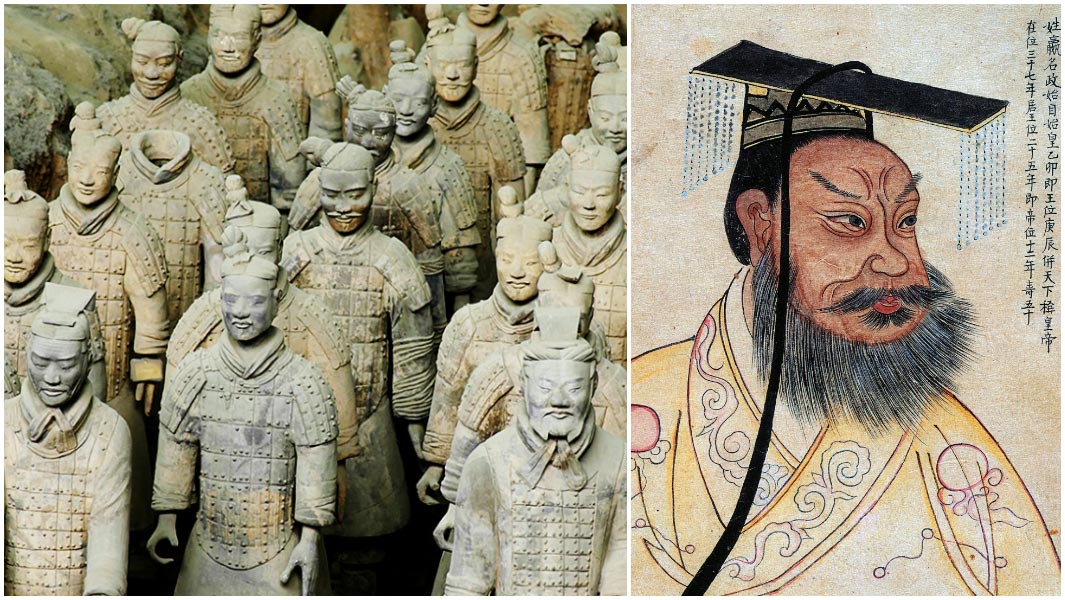The dark history behind the record-breaking Terracotta Army

48 years ago, a horde of life-size clay figures were unearthed near Xi’an, in the Shaanxi province of China. They had been buried there for over 2,200 years.
Known as the "Terracotta Army", they are part of an expansive mausoleum complex built for Qin Shi Huang (259-210 BCE), founder of the Qin dynasty, and first emperor of a unified China.
There are an estimated 6,000 - 8,000 statues in total, making it the largest group of life-size statues in the world.
Not only are they life-size, they are also extremely lifelike. Produced using moulds, each figure was hand-finished with unique facial features.
By a cruel twist of fate, the workers who gave life to these statues lost their own, after allegedly being sealed inside the tomb along with their creations.
Read on to learn about the dark history of one of the greatest archaeological discoveries of the 20th century.
Work began in 246 BCE, when the emperor was a just a 13-year-old king.
Sima Qian (145–90 BCE) wrote about the tomb’s construction a century after its completion, as part of a history of ancient China, titled Shiji (史記) aka Records of the Grand Historian.
He wrote that "more than 700,000 conscripts from all parts of the country" laboured on the grand funerary tomb.
According to Sima Qian, the tomb was filled with models of palaces and other official buildings, as well as precious jewels and rarities. China's waterways and rivers were represented by liquid mercury.
Automatic crossbows were ordered to be installed so that any grave robber would be slain.

Following Emperor Qin Shi Huang's unexpected death in 210 BCE, his son decreed that it would be inappropriate for his father's childless concubines to be free, so they were ordered to follow the First Emperor into the grave.
The live burials didn’t end there though.
Soon after, it was suggested that the artisans responsible for making the tomb's mechanical devices knew too much about the secrets of the treasure hidden inside.
Sima Qian wrote that "the middle gate was shut and the outer gate closed to imprison all the artisans and labourers, so that not one came out."
Trees and grass were then planted over the pyramid-shaped mausoleum to make it look like a hill.

Because the tomb is largely unexcavated – and is likely to remain that way for the foreseeable future – the accuracy of Sima Qian's writings cannot be confirmed.
However, some of his claims have been supported by survey work conducted in the late '90s by archaeologist Dr. Duan Chingbo and his team.
Soil samples they took from the site revealed high contents of mercury, while a magnetic scan also revealed a large amount of coins scattered around the unopened inner tomb of the emperor.

Discovering the Terracotta Army
The location of the mausoleum was never lost, however there was nothing in Sima Qian’s writings mentioning the existence of the Terracotta Army.
The chamber containing the record-breaking clay statues was first discovered in 1974, when a group of local farmers tried to dig a well near the ancient capital city of Chang’an, known today as Xi’an.
The total size of the Terracotta Army is estimated to be between 6,000 - 8,000 figures.
These numbers are extrapolations based on partial excavations of the three main pits containing warriors, as well as newer pits containing non-military figures such as acrobats, musicians and officials.

The statues are all life-size, but vary in height according to their roles, with generals being the tallest.
Of the pits containing soldiers;
- Pit 1 is the largest, accommodating the main army.
- Pit 2 contains mobile forces, such as cavalry and war chariots. It is thought to represent a military guard.
- Pit 3 is much smaller, housing special high-ranking units.
Archaeologists discovered that these pits had later suffered large-scale burning and looting.
Textual research indicates that one of the people responsible for this burning was Xiang Yu, a general that rose up and rebelled against the Qin's tyrannical rule.

The Terracotta Army’s meticulous formation, reflecting the highly-coordinated power of the Qin army, faces east, as if to protect the tomb from the Qin emperor's conquered states.
But it wasn't just a powerful army that allowed China's first emperor to expand his kingdom and unify the country.
Qin Shi Huang also built a new administrative system, national road network and standardized the system of writing, weights and measurements used across the land.

It is likely we will never know the exact number of statues in the Terracotta Army, owing to the fact that not all of the figures are complete, and many exist only in the form of disembodied clay limbs.
Similarly, we will never know exactly how many labourers and artisans lost their lives inside the tomb.
Today, Emperor Qin Shi Huang's Mausoleum Site Park attracts two million visitors annually and is designated as a UNESCO World Heritage site.


